Chapter 3. Igneous Rocks
Overview of Igneous Rocks
How Igneous Rocks Form
Magma Composition
Before any igneous rock can form, molten material—known as magma—must be produced. That means you must have a rock to melt in the first place to make the magma that will eventually cool to become an igneous rock. The composition of the original rock (or rocks) that melted is one of the factors that controls the composition of the igneous rock that forms once the melt cools. Other factors are how much of the original rock actually melts, and the cooling process of the magma.
Rocks are often made up of a mixture of minerals. For each mineral, there is a unique set of conditions (such as pressure and temperature) under which that mineral can melt. For a rock with a mixture of minerals, this means that under certain conditions, some of the minerals in the rock may melt, while other minerals remain solid. Because some minerals melt at lower temperatures than others, temperature conditions determine which minerals will add their chemical components to the magma that forms. If temperatures are low enough, some of the minerals might not melt at all. Therefore, even if the same types of rocks are melting, different magma compositions can be generated simply by melting at different temperatures!
Cooling & Mineral Formation
Eventually, magma will start to rise through Earth’s lithosphere, because it’s more buoyant than its source rock. When the magma moves away from its source region, it encounters new thermal conditions, and begins to cool. As the magma cools, the temperature begins to drop beneath the melting points of different minerals. The sequence in which minerals crystallize is the opposite of the melting sequence, such that minerals with high melting points form first as the magma cools. The order is summarized in Bowen’s reaction series (Figure 3.2) named after Normal L. Bowen, who performed early experiments on cooling melts.
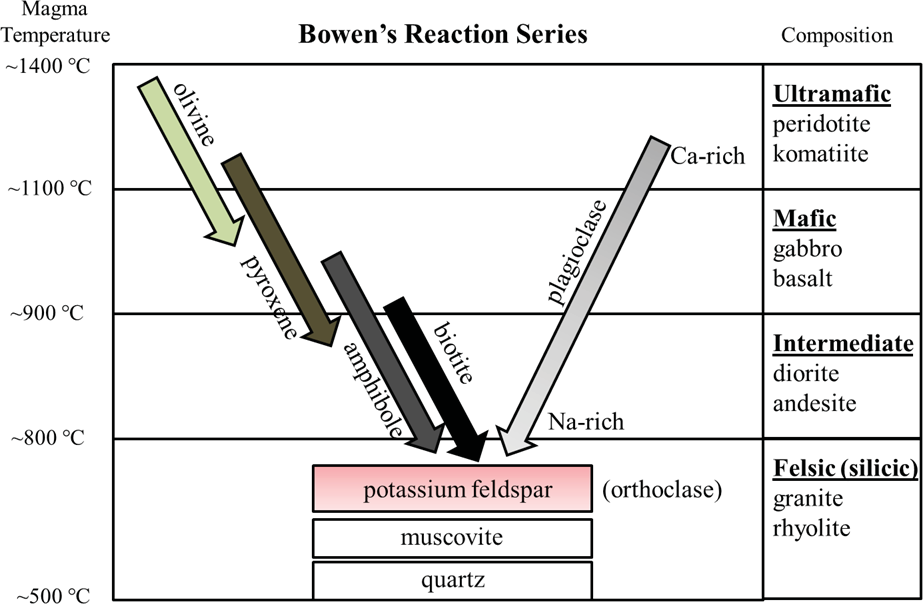
“Reaction series” refers to the sequence of chemical reactions between elements within magma that result in the formation of minerals as the temperature falls. On the diagram, the sequence proceeds from top to bottom. The length of the arrow indicates the range of temperatures at which a particular mineral can form.
The first mineral to crystallize in a cooling magma of ultramafic composition is olivine. Once the temperature falls below this range, olivine crystals will no longer form; instead, other minerals such as pyroxene will start to crystallize. Note that more than one mineral might be forming at a given temperature; for example, within a certain range of temperatures, chemical reactions are forming both olivine and pyroxene.
As mineral crystals form in cooling magma, they take some chemical elements from the magma into their crystal structure, and exclude others. In the case of olivine, magnesium (Mg) and iron (Fe) are taken in, leaving the remaining magma with less Mg and Fe than before crystallization started. This means that the composition of the magma changes as crystals are forming.
On the left side of Bowen’s reaction series, the minerals olivine, pyroxene, amphibole, and biotite all remove iron (Fe), magnesium (Mg), and manganese (Mn) from magma during crystallization, but do so over different temperature ranges. These iron- and magnesium-rich minerals are referred to as ferromagnesian minerals (ferro = iron) and are usually green, dark gray, or black in colour due to the absorption of visible light by iron and magnesium atoms.
On the right side of Bowen’s reaction series is a long arrow labelled plagioclase feldspar. Plagioclase treated separately because it crystallizes continuously over a large temperature range. As the magma temperature drops and plagioclase first begins to crystallize, it will take calcium atoms into its crystal structure, but as the temperature drops, plagioclase takes in sodium atoms in increasing abundance, and less and less calcium. The difference in calcium and sodium content make a difference in the appearance of plagioclase: the higher temperature calcium-rich plagioclase is dark gray in colour, while the lower temperature sodium-rich plagioclase is white.
At the bottom of Figure 3.2 are potassium feldspar, muscovite, and quartz, the low-temperature minerals that are the last to form during cooling (and therefore the first to melt as a rock is heated). These minerals form from magma that has been depleted of iron and magnesium, and so are referred to as non-ferromagnesian minerals. Non-ferromagnesian minerals are much lighter in colour. For example, the potassium-rich feldspar (also known as orthoclase) can be a pale pink or white in colour. The colour of an igneous rock will be affected by its mineral content, so a general knowledge of mineral colour is helpful for identifying and classifying igneous rocks.
Igneous Rock Composition
On the right side of the Bowen’s reaction series diagram are the igneous rock composition categories, and examples of common igneous rock names in each category. The compositional categories are defined by the minerals found within them. For example, in ultramafic rocks like peridotite or komatiite, you can expect to find abundant olivine, and maybe some pyroxene and Ca-rich plagioclase. In mafic rocks like basalt or gabbro, you can expect to find pyroxene, plagioclase, and possibly some olivine or amphibole. In a felsic (or silicic) rock such as granite or rhyolite, you can expect to see quartz, muscovite, potassium feldspar, and some biotite and Na-rich plagioclase.
Hint for remembering the terms mafic and felsic:
In the word mafic, the “ma-” comes from magnesium, and the “fic” refers to ferric iron.
The word felsic combines “fel-” from feldspar and “sic” from silica-rich quartz.
Effect of Mineral Content on Rock Colour
The classification of an igneous rock depends partly on the minerals that may be present in the rock. Minerals have certain colours due to their chemical makeup, meaning that igneous rocks with a particular mineral composition must also have certain characteristic colours. In general:
- An ultramafic rock composed of mostly olivine will be green in colour due to olivine’s green colour.
- A mafic rock with large amount of ferromagnesian minerals in it will dark-coloured because the ferromagnesian minerals (other than olivine) tend to be dark coloured.
- Felsic igneous rocks with a large amount of non-ferromagnesian minerals will be light in colour.
- A rock that is considered intermediate between the mafic and felsic rocks is truly an intermediate in terms of the colour and mineral composition; such a rock would have fewer dark minerals grains than the mafic rocks, yet more dark mineral grains than felsic rocks.
So, based on colour alone, we can to start classify igneous rocks.
Test Your Understanding: Igneous Rocks by Colour
Click to launch the activity in a new window.
Figure 3.3 | Examples of the four compositional categories of igneous rocks.
Mafic Colour Index (MCI)
Classifying rocks into one of the igneous rock compositions (ultramafic, mafic, intermediate, and felsic) depends on the minerals that each rock contains, but it can sometimes be difficult to identify the minerals in a rock. A simplified method of determining the igneous rock composition is by estimating the percentage of dark-coloured ferromagnesian minerals in the rock, without trying to identify the actual minerals present. This method of classification relies on a mafic colour index (MCI), which counts the proportion of dark gray, black, or green minerals visible in a rock. Table 3.1 shows approximate ranges for the four compositional categories. In reality, the MCI will vary for individual rock types. In the Reference Tools for Igneous Rocks section there is a diagram that will help you estimate the percentages. (Don’t try to do this without the reference diagram. It’s notoriously difficult to do well, even among people who are experienced at examining rocks.) Reference Tools also includes a flowchart with more specific information about MCI for different igneous rocks.
| Table 3.1 Mafic Colour Index (MCI) |
|
| Compositional Category | Fraction of Dark Components |
| Felsic | 0-25% (typically < 20%) |
| Intermediate | 20-50% (typically 25-45%) |
| Mafic | 35-80% (typically 45-75%) |
| Ultramafic | 65-100% (typically >80%) |
Estimating the amount of mafic minerals is only possible if the minerals are large enough to see. If the minerals are too small to see with the unaided eye, it’s still possible to recognize rocks in the different compositional categories by their colour: ultramafic rocks will be greenish, mafic rocks will be dark (Figure 3.4A), felsic rocks will be lighter (sometimes pinkish; Figure 3.4C), and intermediate rocks will be somewhat lighter than a mafic rock, yet darker than a felsic rock (Figure 3.4B).

Igneous Rock Texture
The classification of igneous rocks is based not just on composition, but also on texture, the features and surface characteristics that we see in a rock. These can include the sizes of minerals, the presence of glass or rock fragments, and holes related to gas bubbles.
Mineral Crystal Size (Grain Size)
For mineral crystals to form, the chemical elements that become part of the mineral must migrate from the liquid magma to where the crystal is growing, then bond with other elements in a particular way to form the unique crystal structure for that mineral. When magma cools slowly, the chemical elements needed to form a certain mineral have more time to migrate and accumulate; that mineral can become large enough to see without the aid of a microscope.
Rocks having crystals that are visible to the unaided eye have a phaneritic (or coarse-grained) texture (from the Greek word phanerós, meaning “visible”). The rocks in Figure 3.3 all have a phaneritic texture. For most of them this is easy to spot because the different minerals show up as different colours. For the gabbro in the upper left, however, this is more difficult to see because of the dark colour. The rock in Figure 3.5B is also phaneritic. If a phaneritic rock has especially large crystals (with grains being larger than 1 cm on average), it’s called pegmatite.
When the opposite scenario happens, and magma cools quickly, there is less time for chemical elements to migrate and form large mineral crystals. In this case, many microscopic mineral crystals of a particular mineral will form; these igneous rocks have an aphanitic (or fine-grained) texture. (“Aphanitic” means “not visible.”) Figure 3.4A and 3.4C are good examples of aphanitic rocks.
Sometimes an igneous rock will have some crystals that are distinctly larger than others in the same rock. This occurs when cooling happens at different rates: slower cooling permits the larger crystals to form, and then a switch to rapid cooling caused the remaining melt to crystallize as much smaller crystals. The distinctly larger crystals are called phenocrysts. An igneous rock with phenocrysts is said to have a porphyritic texture.
Figure 3.5 shows two examples of porphyritic igneous rocks, but notice that the over-all crystal sizes of each rock are different. Figure 3.5A is both aphanitic and porphyritic, while Figure 3.5B is both phaneritic and porphyritic. In Figure 3.4B, the white spots are phenocrysts, making it aphanitic and porphyritic also.
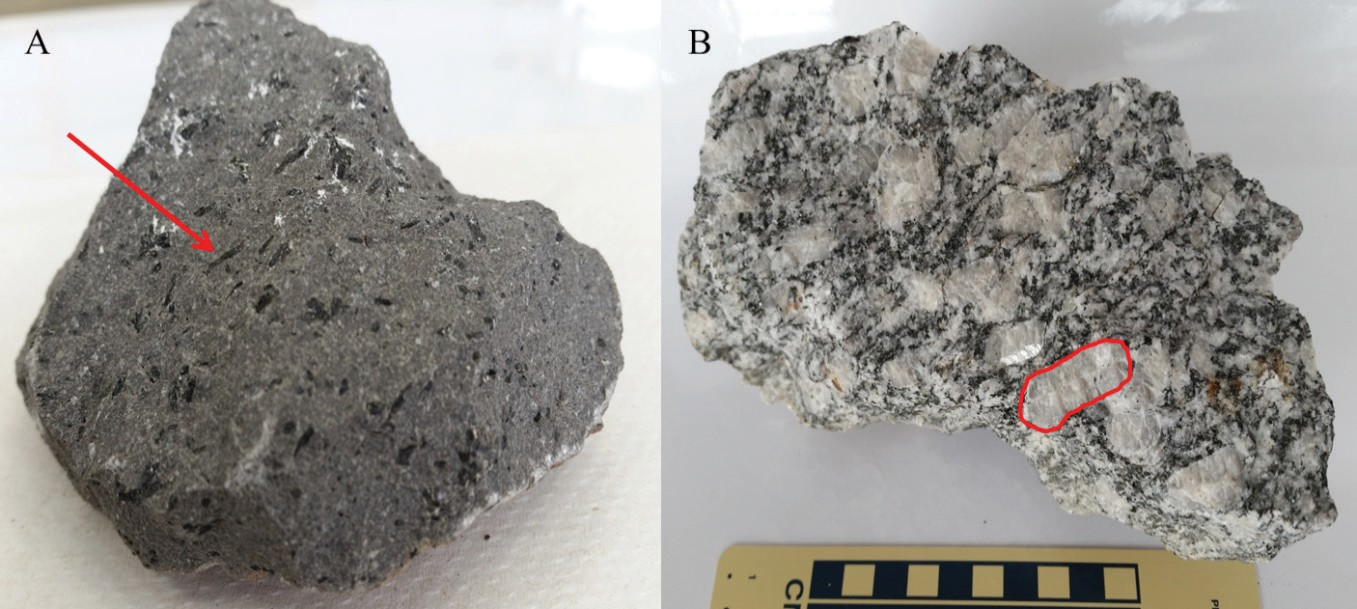
If magma cools so quickly that there isn’t time for the chemical elements in the magma to migrate into a crystal structure, glass forms. Glass is a chaotic arrangement of chemical elements, so by definition it is not considered a mineral. Igneous rocks composed primarily of glass are said to have a glassy texture.
Obsidian (Figure 3.6A) is a dense type of glass that looks as you might expect glass to look. The identification of a glassy rock such as obsidian is easy once you recall the properties of glass; any thick glass pane or a glass bottle that is broken will have a smooth, curve shaped pattern on the broken edge called conchoidal fracture. If you look closely at the obsidian in Figure 3.6A, you will see curved surfaces on the rock. Obsidian appears dark in colour regardless of its composition because it is a dense glass, and light cannot pass through this thick glass.
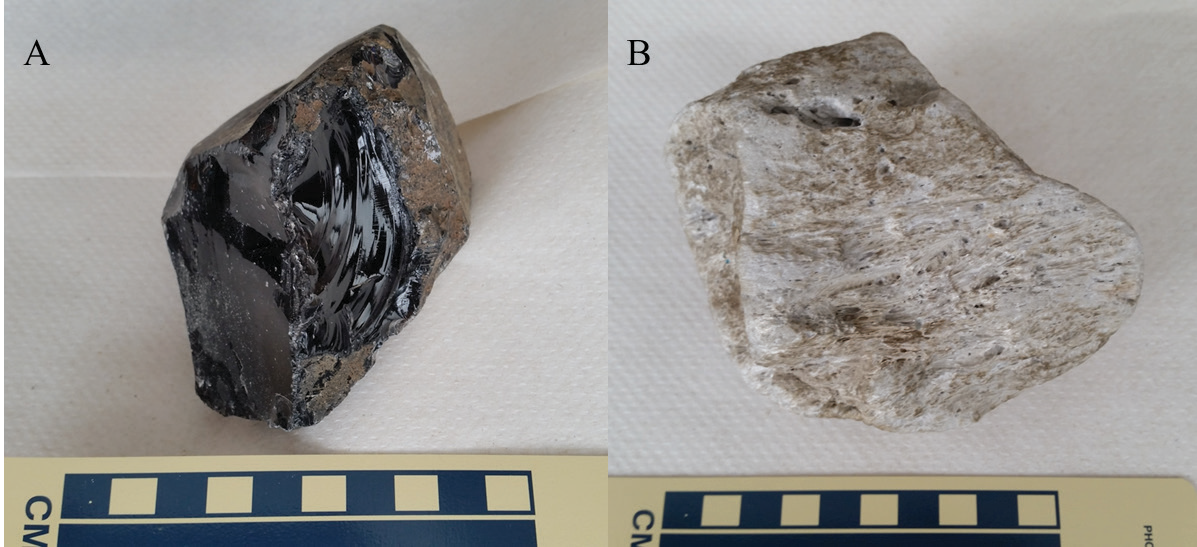
Source: Karen Tefend (2015) CC BY-SA 3.0 View source.
Pumice (Figure 3.6B) is another igneous rock also composed primarily of glass due to a very fast rate of cooling. In pumice, the glass is stretched into very fine fibers of glass which formed during a volcanic eruption from lava that was frothy with gas. Pockets of air within the pumice are why it can float on water. The glass fibers in pumice are very thin, so they break easily, but any conchoidal fracture in these fibers is too small to see without the aid of a microscope. Pumice is distinctive because it’s remarkably light for a rock its size.
Light-coloured pumice is felsic or intermediate in composition. The mafic counterpart, called scoria, comes in dark grey, red, or black.
Intrusive or Extrusive?
Magma below Earth’s surface tends to cool slowly because the surrounding rock acts as an insulator to limit how much heat can escape. Magma that stays within the Earth can take tens of thousands of years to completely crystallize, depending on the size of the magma body. Because of the long time-frame for cooling, upon inspection of this rock, you would find that the minerals were large enough to see without a microscope. In other words, it would have a phaneritic texture. Any time we see an igneous rock with a phaneritic texture, we know that it formed from magma that forced its way into the surrounding rocks—intruding into them—but never reached Earth’s surface. Igneous rocks that form this way are intrusive igneous rocks.
In contrast, if magma reaches Earth’s surface (at which point it is referred to as lava), it is no longer insulated by the rocks around it and will cool rapidly. Any rock that forms from lava will have either an aphanitic texture due to fast cooling, or a glassy texture due to very fast cooling. Rock that forms from lava extruded onto Earth’s surface is an extrusive igneous rock.
Magma that escapes Earth’s interior will lose some of its dissolved gas. If the lava hardens around gas bubbles while these gases are escaping, a small hole or vesicle will form in the rock (Figure 3.7). Igneous rocks full of holes from gas bubbles (vesicles) have a vesicular texture. This is a common texture in mafic lava flows. Pumice and scoria also have vesicular texture.
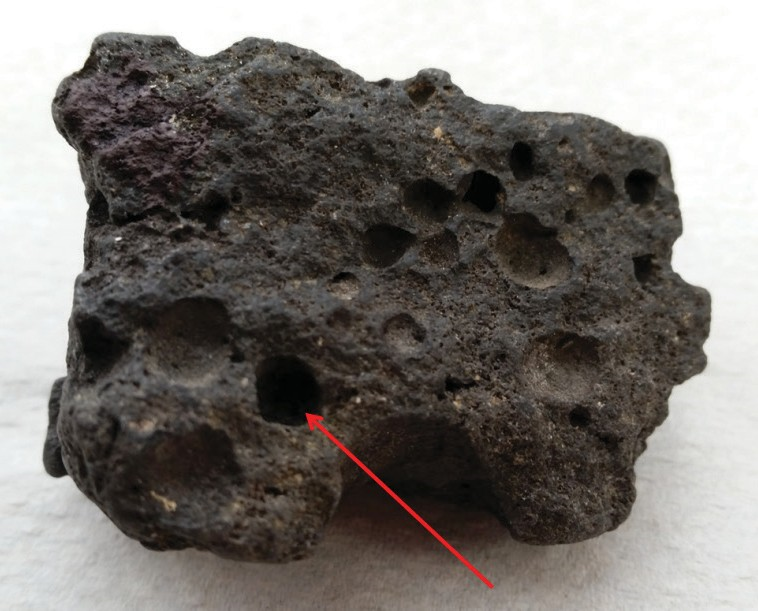
Vesicles can be filled with a secondary mineral, such as quartz or calcite, long after the rock was formed; these filled vesicles are known as amygdules, and their presence gives the rock an amygdaloidal texture (Figure 3.8).
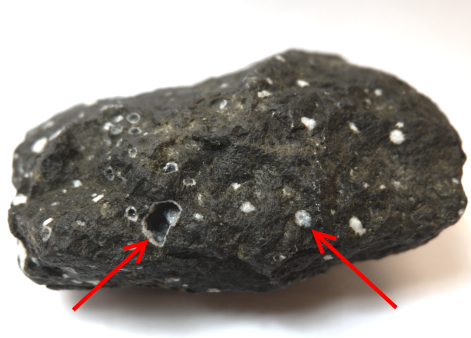
Aphanitic rocks with a porphyritic texture are still considered to be extrusive rocks because the magma eventually emerged onto Earth’s surface as lava, and cooled there. The presence of phenocrysts tells us that crystallization started before the magma escaped Earth’s interior, but finished after the lava erupted.
Igneous Rock Names
The system for naming igneous rocks divides up rocks based on their composition (ultramafic, mafic, intermediate, or felsic), but also based on how they cooled (whether they are intrusive or extrusive). This system means that chemically identical rocks can have different appearances and different names depending on how they formed. For example, if mafic magma cools within the Earth, the resulting rock is gabbro. If it erupts and cools as a lava flow, then the rock that results is basalt. Table 3.2 lists the intrusive and extrusive equivalents of common igneous rocks in each compositional category.
| Table 3.2 Common Igneous Rocks |
||
| Compositional Category |
Intrusive Rock Name |
Extrusive Rock Name |
| Ultramafic | Peridotite | Komatiite |
| Mafic | Gabbro | Basalt |
| Intermediate | Diorite | Andesite |
| Felsic | Granite | Rhyolite |
Using the intrusive or extrusive rock name automatically tells us whether the texture is phaneritic or aphanitic, but we include other relevant textural terms. For example, basalt with vesicles is called vesicular basalt. Andesite with phenocrysts is called porphyritic andesite. Basalt with vesicles and phenocrysts is porphyritic vesicular basalt.
Have A Closer Look
Sometimes the dark crystals in peridotite can be difficult to see if they are small. Zoom in on the image below to get a better look. The peridotite in the sample is a xenolith, and it is contained within basalt. The basalt has vesicles and amygdules. Can you find them?
Source: Robin Rohrback, Mid-Atlantic Geo-Image Collection. CC BY-NC.
Click here to examine more igneous rocks close-up.

